You can dehydrate just about any type of food, whether it be a fruit, vegetable, herb, or spice in a food dehydrator! Eggplant is no exception.
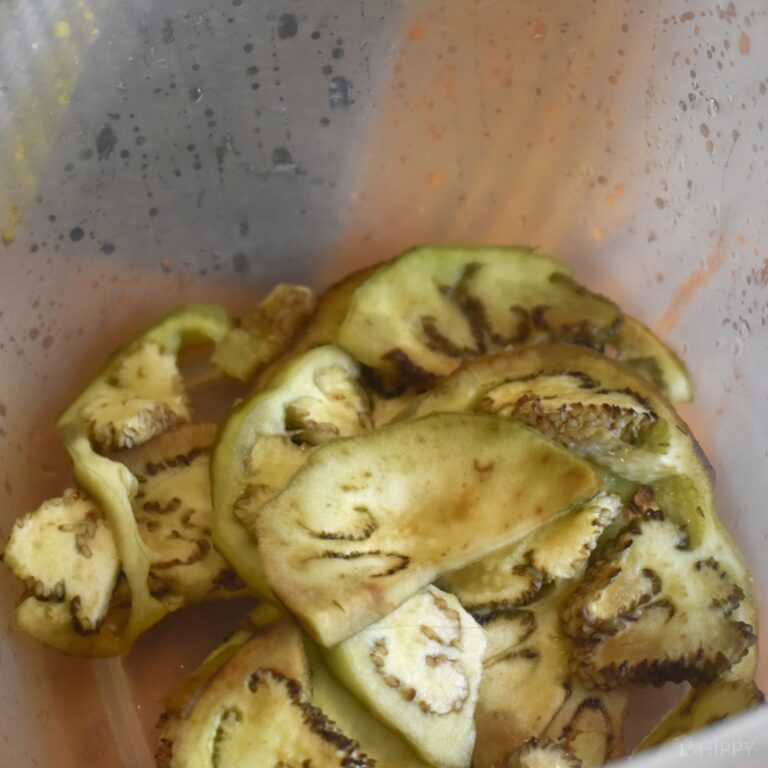
Some people are turned away from the idea of eggplant in a food dehydrator, finding the lack of color in the dried eggplant unappealing.
However, dried eggplant is a great way to use up all the eggplant from your garden, and using a dehydrator helps prevent unnecessary spoilage that occurs when you dehydrate eggplant in the sun.
You can use any type of eggplant for dehydration, and there is not one type of eggplant that works better than another. However, you will want to search for smaller eggplants, as large ones will need to be cut into smaller slices.
Small pieces of eggplant taste less time to dry and there’s also a reduced likelihood that they will taste bitter – making them optimal candidates for this job.
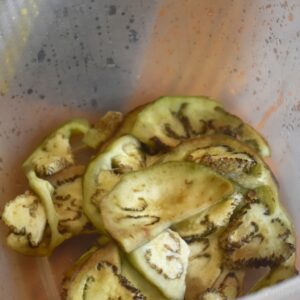
Classic Recipe for Dehydrating Eggplant
Ingredients
- 6 small eggplants
- salt optional
Instructions
- Start by washing your eggplant completely. The choice is up to you regarding whether you want to peel your eggplant or not, but either way, you will want to do the best job you can to get any dirt or pesticides off your eggplant.
- Once you’ve washed your eggplants, you will need to slice them. The best size for slicing is about ¼ inch thick. You can dehydrate with the skin on or off, but make sure you slice extra-thin if you plan on leaving the skin on (the skin is best on young eggplants, too).
- You can also choose to cut your eggplant into one-inch cubes. This choice depends on your ultimate goals for how you want to use your dehydrated eggplant. Use the sharpest knife you can find to create these slices. This will allow for even, equal amounts of drying.
- Next, you will need to blanch your sliced eggplant. This will not only add flavor to the vegetables, but will also help aid in long-term preservation. Blanch by boiling water or via the steaming process. The steaming process is particularly helpful when you are blanching eggplant for the purpose of dehydration. It allows the pieces of eggplants to retain more nutrients and is also quite easy to do. All you need to do is put the eggplant slices in a strainer that is rested on the top of a pot of boiling water.
- Allow the eggplant to steam for about four minutes. You can then place the strainer in cold water to further halt the cooking process.
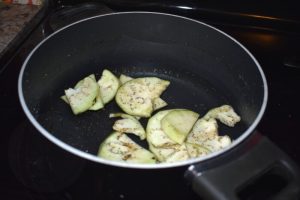
- Next, you’ll need to use the non-stick drying trays on your food dehydrator to layer your eggplant. Spread the slices among the trays in a single layer, allowing no one slice to overlap another.
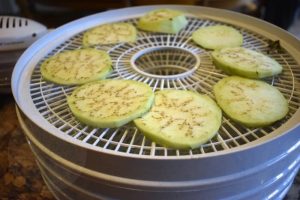
- Set the dehydrator to medium, and place the trays inside, allowing the machine to dry the eggplant for 12 to 24 hours, depending on how brittle you want your finished product to be. You may find that you need to rotate your trays every few hours, moving the bottom trays to the top and vice versa. This will prevent the eggplant slices from becoming too brittle.
Keep in mind that setting the dehydrator to high might destroy some of the plant’s nutrients while setting it to low will take longer to finish.
Still not sure where to start? Here’s a video on how to dehydrate and use eggplant for everybody’s favorite – eggplant parmesan:
How to Dehydrate Eggplant Without a Dehydrator
Don’t have a dehydrator? No problem. Although eggplant dehydrates fairly well in a dehydrator, and this is the preferred method of doing so, you can also dehydrate eggplant in the oven.
You’ll follow all the same steps for selecting, preparing, and blanching your eggplant as listed above – but you won’t progress to using a dehydrator.
To do this, all you need to do is set your oven to the lowest possible heat setting. Make sure your eggplant is sliced nice and thin, and let them dehydrate for as long as needed – usually up to eight hours and no more.
Storing and Using Dehydrated Eggplant
You can easily store your dehydrated eggplant in an airtight jar. The pieces don’t have to be eaten just as chips, either. You can easily rehydrate your dried eggplant by pouring hot water over the pieces, which will serve you quite well when you are making dishes like chili, meatballs, or soups that require the use of fresh eggplant.
Some people store their dehydrated eggplant in bags. You can do this, but it may affect the dehydration as more air can be lost from a plastic bag.
Wrap-Up
Dehydrating eggplant is not difficult to do, and it’s a great way to use up all of your excess eggplants without taking up a ton of room in your freezer.
Interested in learning more about other ways to preserve eggplant? Make sure you check our article out. Oh, and please pin this article for later on your favorite Pinterest board!
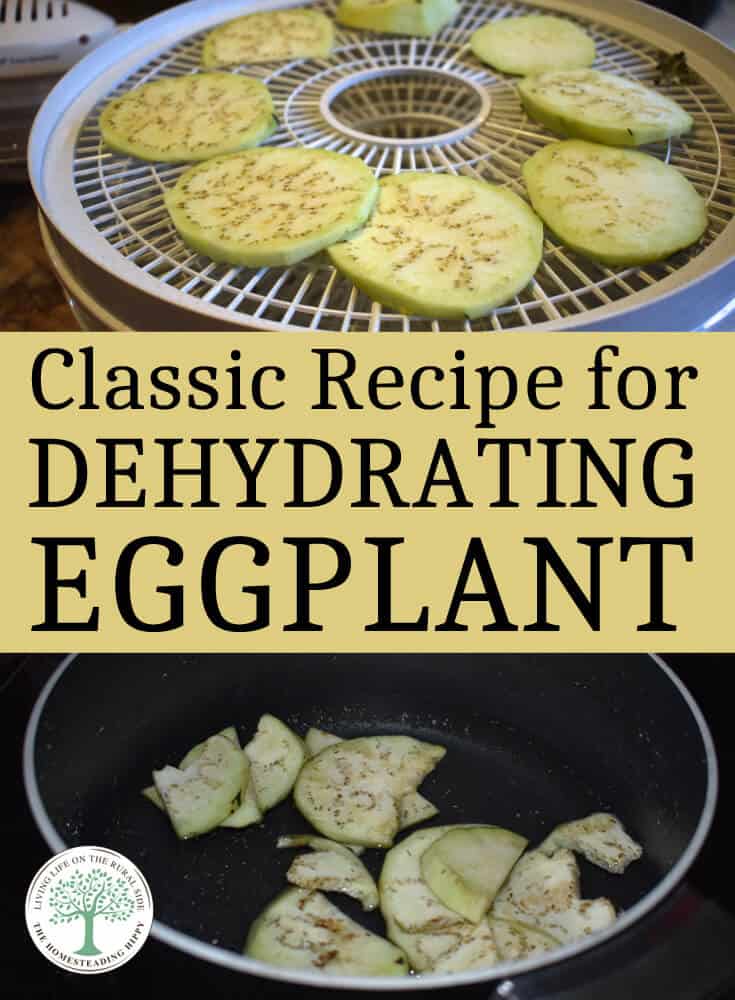

Rebekah is a full-time homesteader. On her 22 acres, she raises chickens, sheep, and bees, not to mention she grows a wide variety of veggies. She has a huge greenhouse and does lots of DIY projects with her husband in her ever-growing homesteading endeavor. Learn more about Rebekah here.

I just planted some eggplant in my garden and I’m so excited to begin harvesting! I have made zucchini lasagna in the past and I am anxiously awaiting the arrival of my eggplants to do the same. My zucchini lasagna has turned out watery due to so much moisture in the zucchini so my question is, have you ever tried to use partially dehydrated eggplant in a lasagna recipe? I would imagine it may be the key to a less watery lasagna. I’m definitely going to test this theory!
Hi, I’m excited to learn abt dehydrating foods & how to use them in recipes. Thank you for teaching such an important part of homesteading.
Sandee
Slice the summer squash, zucchini, courgets, eggplant, then lightly salt it. Toss the veggies gently to distribute the salt. Set it aside for 10 or 15 minutes for the salt to draw out moisture. Pour off moisture & rinse salt off, squeeze dry in a dishtowel or other smooth cloth. Then proceed with your recipe.
Tried this recipe and was very pleased with it.
HI Megan, I’ve made eggplant lasagna and have not had it watery at all. I have made it with fresh eggplant and use them as ‘pasta’. I have sprinkeled just a bit of bread crumbs on the layers. My husband and I really enjoy this.
I normally soak my eggplant in salt water before I cook them to help get rid of the bitterness.Do I need to do this if I am prepping them for dehydration?Or can I put the salt in the water for steaming?
Can dehydrated eggplant be ground and used for flour?